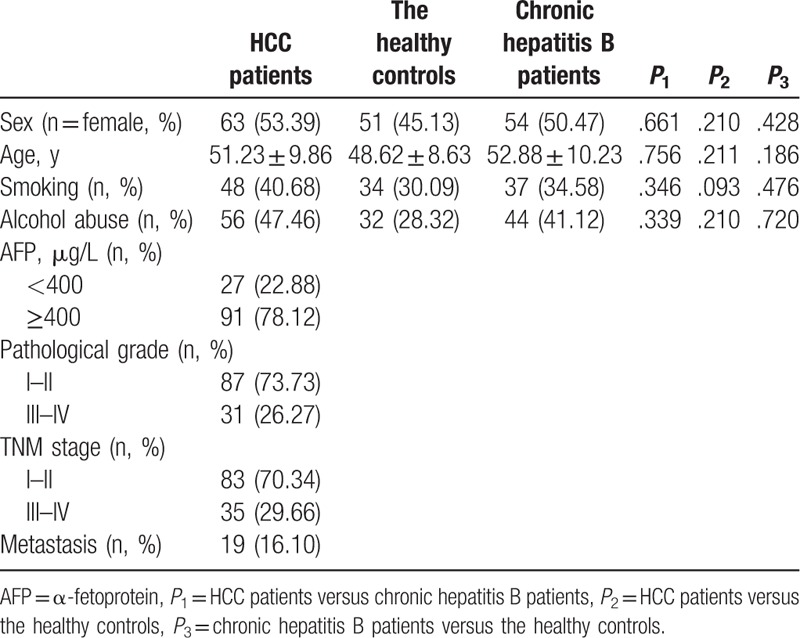This research aimed to discover the genetic affiliation of polymorphisms in caveolin-1 gene (CAV1) with hepatitis B virus-related hepatocellular carcinoma (HBV-related HCC) susceptibility in a Chinese Han inhabitants.The genotyping of polymorphism was performed utilizing polymerase chain reaction-restriction fragment size polymorphism methodology.
Whether the genotype distribution of polymorphisms in the wholesome controls was in step with Hardy-Weinberg equilibrium (HWE) was detected. The genotype and allele frequency distinction between the two teams was in contrast by chi-square check. Odds ratio (OR) and 95% confidence interval (95% CI) had been calculated to indicate the relative danger of HCC which resulted from genetic variants in CAV1. Moreover, the linkage disequilibrium of CAV1 polymorphisms was analyzed by Haploview.
The AG genotype and A allele of rs1049334 confirmed considerably increased frequency in HCC sufferers than that of continual HBV sufferers and the wholesome controls (P < .05); so their carriage clearly elevated the susceptibility to HBV-related HCC, irrespective of the very fact whether or not people had been contaminated with hepatitis B virus or not (AG vs GG: OR 1.958, 95% CI 1.050-3.650, OR 1.899, 95% CI 1.034-3.487; A vs G: OR 1.667, 95% CI 1.033-2.689, OR 1.777, 95% CI 1.103-2.863).
Additionally, A-G haplotype of rs3807989-rs1049334 confirmed the protecting position for HBV-related HCC (OR 0.102, 95% CI 0.035-0.293; OR 0.135, 95% CI 0.046-0.395).CAV1 rs1049334 polymorphism is considerably related to the incidence danger of HBV-related HCC, and the interplay of polymorphisms shouldn’t be uncared for.

Epigenetic Regulation of Caveolin-1 Gene Expression in Lung Fibroblasts.
Fibrotic problems are related to tissue accumulation of fibroblasts. We lately confirmed that caveolin (Cav)-1 gene suppression by a profibrotic cytokine, reworking development issue (TGF)-β1, contributes to fibroblast proliferation and apoptosis resistance.
Cav-1 has been proven to be constitutively suppressed in idiopathic pulmonary fibrosis (IPF), however mechanisms for this suppression are incompletely understood. We hypothesized that epigenetic processes contribute to Cav-1 down-regulation in IPF lung fibroblasts, and after fibrogenic stimuli.
Cav-1 expression ranges, DNA methylation standing, and histone modifications related to the Cav-1 promoter had been examined by PCR, Western blots, pyrosequencing, or chromatin immunoprecipitation assays in IPF lung fibroblasts, regular fibroblasts after TGF-β1 stimulation, or in murine lung fibroblasts after bleomycin harm. Methylation-specific PCR demonstrated methylated and unmethylated Cav-1 DNA copies in all teams.
Despite vital modifications in Cav-1 expression, no modifications in DNA methylation had been noticed in CpG islands or CpG island shores of the Cav-1 promoter by pyrosequencing of lung fibroblasts from IPF lungs, in response to TGF-β1, or after bleomycin-induced murine lung harm, in comparison with respective controls. In distinction, the affiliation of Cav-1 promoter with the energetic histone modification mark, H3 lysine four trimethylation, correlated with Cav-1 down-regulation in activated/fibrotic lung fibroblasts.
Our knowledge point out that Cav-1 gene silencing in lung fibroblasts is actively regulated by epigenetic mechanisms that contain histone modifications, in explicit H3 lysine four trimethylation, whereas DNA methylation doesn’t seem like a main mechanism. These findings help therapeutic methods that concentrate on histone modifications to revive Cav-1 expression in fibroblasts collaborating in pathogenic tissue reworking.
